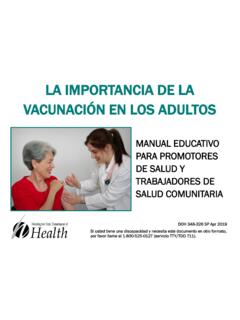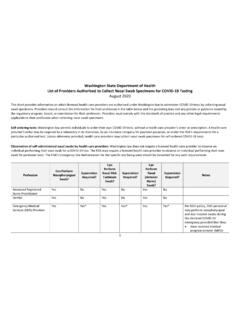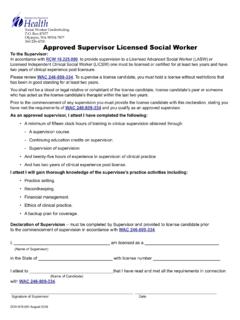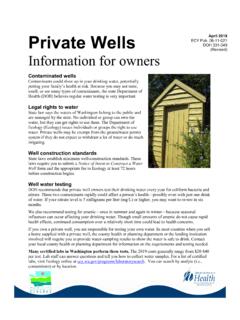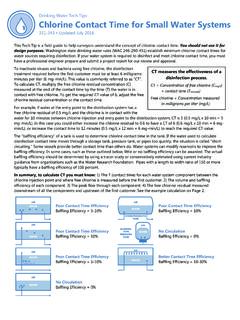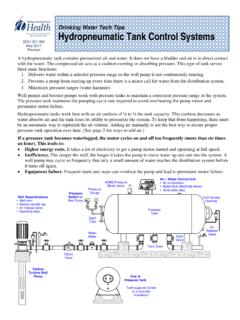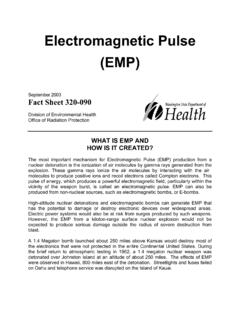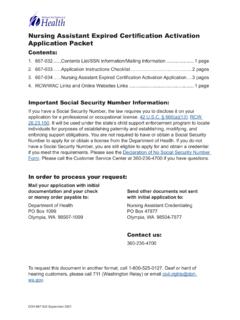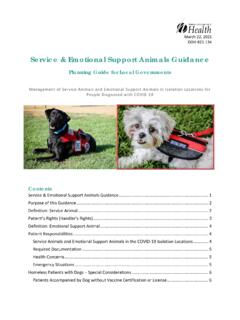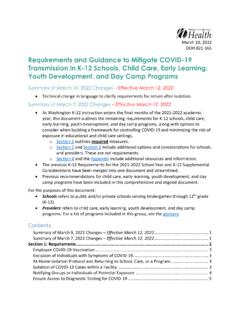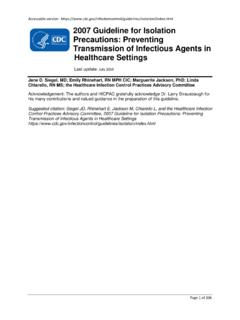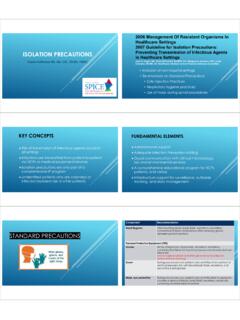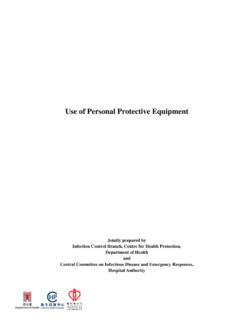Transcription of Long-Term Care Facility Testing for Staff and Residents
1 W A S H I N G T O N STATE DEP A R T M E N T OF HEALTH. SARS-CoV-2 Infection Prevention and Control in Healthcare Settings Toolkit 2023. DOH 420-474 June 2023. To request this document in another format, call 1-800-525-0127. Deaf or hard of hearing customers, please call 711 (Washington Relay) or email Table of Contents Abbreviations .. 3. Background and Purpose .. 4. Infection Prevention and Control Program and Plan .. 5. Elements of COVID-19 Prevention in All Healthcare Settings .. 6. Screening .. 6. Hand Hygiene .. 7. Environmental Infection Control Cleaning and Disinfection .. 7. Ventilation .. 8. Personal Protective Equipment (PPE) and Transmission-Based precautions (TBP).
2 9. Table 1: HCP's How to Use PPE .. 10. Source Control .. 11. Source Control Versus PPE .. 11. Aerosol-generating Procedures (AGP) .. 12. Patient Isolation and Quarantine .. 13. Isolation Versus Quarantine .. 14. Table 2: Summary of SARS-CoV-2 Isolation and Quarantine .. 14. Considerations for Healthcare Personnel .. 15. Testing .. 16. Considerations for Immunocompromised People .. 17. Setting Specific Checklists .. 18. Long Term Care Facilities .. 18. Considerations for Memory Care .. 20. Hospitals .. 22. Other Setting Specific Resources .. 24. Considerations for Assisted Living, Group Homes, and Other Residential Care 24.
3 Additional Resources .. 25. Jurisdiction Map .. 26. Webinars and Information Sessions .. 26. Additional Resource Links .. 27. Abbreviations ABHS: alcohol-based hand sanitizer ACH: air changes per hour AGP: aerosol generating procedure AIIR: airborne infection isolation room ASHRAE: American Society of Heating, Refrigerating and Air-Conditioning Engineers CDC: [United States] Centers for Disease Control and Prevention CMS: [United States] Centers for Medicare and Medicaid Services DOH: [Washington State] Department of Health DOSH: [Washington State Labor & Industries] Division of Occupational Safety and Health DSHS: [Washington State] Department of Social and Health Services EPA.
4 [United States] Environmental Protection Agency EVS: environmental services HCP: healthcare personnel HSQA: [Washington State Department of Health] Health Systems Quality Assurance LHJ: local health jurisdiction LTCF: Long-Term care Facility L&I: [Washington State Department of] Labor and Industries NAAT: nucleic acid amplification test NIOSH: National Institute of Occupational Health and Safety PCR: polymerase chain reaction PPE: personal protective equipment OSHA: [United States] Occupational Safety and Health Administration TBP: transmission-based precautions SARS-CoV-2: severe acute respiratory syndrome coronavirus 2.
5 SNF: skilled nursing Facility (nursing home). WHO: World Health Organization DOH Infection Control Toolkit 3. Background and Purpose The Washington State Department of Health (DOH) developed this toolkit for healthcare settings to use to prevent transmission of severe acute respiratory syndrome coronavirus 2. (SARS-CoV-2), the virus that causes coronavirus disease 2019 (COVID-19). Healthcare settings may use this toolkit to create flexible policies specific to their Facility based on their individual risk assessment following CDC's Interim Infection Prevention and Control Recommendations for Healthcare Personnel During the Coronavirus Disease 2019.
6 (COVID-19) Pandemic. The WA DOH is in full alignment with CDC's guidance as it pertains to healthcare and COVID-19. In general, healthcare settings should follow Center for Disease Control and Prevention (CDC). guidance to prevent transmission of SARS-CoV-2: Interim Infection Prevention and Control Recommendations for Healthcare Personnel During the Coronavirus Disease 2019 (COVID-19) Pandemic Overview of Testing for SARS-CoV-2, the virus that causes COVID-19. Interim Guidance for Managing HCP with SARS-CoV-2 Infection or Exposure to SARS- CoV-2. Strategies to Mitigate HCP Staffing Shortages Summary for Healthcare Facilities: Strategies for Optimizing the Supply of Personal Protective Equipment (PPE) during Shortages Note: The resources in this document are not regulatory in nature except when required by a regulatory agency such as Washington State Department of Labor & Industries (L&I), Washington State Department of Social and Health Services (DSHS), DOH-Health Systems Quality Assurance (HSQA), and Centers for Medicaid and Medicare Services (CMS).
7 When creating policy and procedures, healthcare settings should ensure they meet regulatory requirements. The resources in this document are tools your Facility can use as a guide to stay in line with state and national standards. This is an interim document, and we will update it with changes in national and state guidance and most recent evidence and data. DOH Infection Control Toolkit 4. Infection Prevention and Control Program and Plan Healthcare facilities should have a person dedicated to infection prevention and control and a plan to mitigate the risk of infection transmission. Some healthcare settings have specific regulatory requirements for infection prevention and control.
8 Please refer to regulatory agencies (L&I, DSHS, HSQA, and CMS) for regulatory requirements. At minimum, an infection prevention and control program should include: 1) Guidelines, policies, and procedures. 2) Education and training. 3) Surveillance. 4) Monitoring, auditing, and feedback. From: WHO's core components of infection prevention and control program DOH Infection Control Toolkit 5. Elements of COVID-19 Prevention in All Healthcare Settings Screening Follow CDC recommendations to ensure that everyone entering the Facility is aware of infection prevention and control practices, including, but not limited to the following: Post visual alerts and signs at the entrance and strategic places.
9 Include a publication or posting date to alert people that signs reflect current recommendations. Provide instructions when scheduling appointments. Establish a process for everyone entering the Facility . Regardless of vaccination status, people entering the Facility should be screened and report any of the following: o A positive viral test for SARS-CoV-2. o Symptoms of COVID-19. o Close contact with someone with SARS-CoV-2 infection (for patients and visitors). o A higher-risk exposure (for HCP). HCP should report any of the criteria above to occupational health or the person the Facility designated, so they can be managed properly.
10 See CDC's HCP. Exposure and Exclusion from Work and CDC Mitigating Healthcare Worker Staffing Shortage for guidance managing HCP with SARs-Cov-2 infection or exposure. Visitors with a positive viral test for SARS-CoV-2 or symptoms of COVID-19 should postpone non-urgent in-person visits until they meet the criteria for ending isolation in Section 2 of CDC recommendations. Visitors who had close contact with someone with SARS-CoV-2, or who were in another situation that put them at higher risk for transmission, should postpone non- urgent, in-person visits until 10 days after their close contact if they meet any of the criteria in Section 2 of CDC recommendations ( , cannot wear source control).
